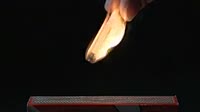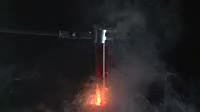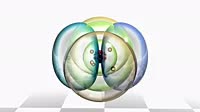Animation depicting the photoelectric effect. This is a physical process in which metals emit electrons when light is shone on them. The set-up here shows a circuit with a battery and light bulb, and two plates of metal. When red (long wavelength, low energy) light is shone on the metal, nothing happens: in the inset circle the electrons (blue) remain within the metal. When the light is replaced with a violet (shorter wavelength, higher energy) one, electrons are seen to leave the metal. This bridges the gap between the plates and the circuit is completed, and the bulb shines. The fact that it is only the frequency of the light that matters, not its intensity or duration of exposure, was a puzzle for classical physics. Albert Einstein explained the phenomenon in 1905, with his theory of energy being quantised into discrete packets, now called photons. This began the field of quantum mechanics, and earned Einstein the 1921 Nobel Prize for Physics.
Details
WebID:
C01808778
Clip Type:
RM
Super High Res Size:
1920X1080
Duration:
00:00:38.000
Format:
QuickTime
Bit Rate:
25 fps
Available:
download
Comp:
200X112 (0.00 M)
Model Release:
NO
Property Release
No













 Loading
Loading